A Review of AI Tools and Their Applications in Modern Networking
VerifiedAdded on 2023/06/04
|8
|2237
|394
Report
AI Summary
This report provides a literature review of artificial intelligence (AI) tools and their applications in networking. It covers various AI techniques used in social media analytics, including tools like Crimson Hexagon, and discusses the challenges of data collection and analysis. The report also explores AI's role in emerging heterogeneous networks (HetNets), focusing on self-maintenance, self-management, and self-optimization using machine learning, fuzzy neural networks, and bio-inspired algorithms. Additionally, it examines the use of AI in intrusion detection systems (IDS) for network security and discusses AI-enabled networking techniques for resource management and data analysis. The report references several key articles in the field, highlighting the benefits and limitations of different AI approaches in networking.
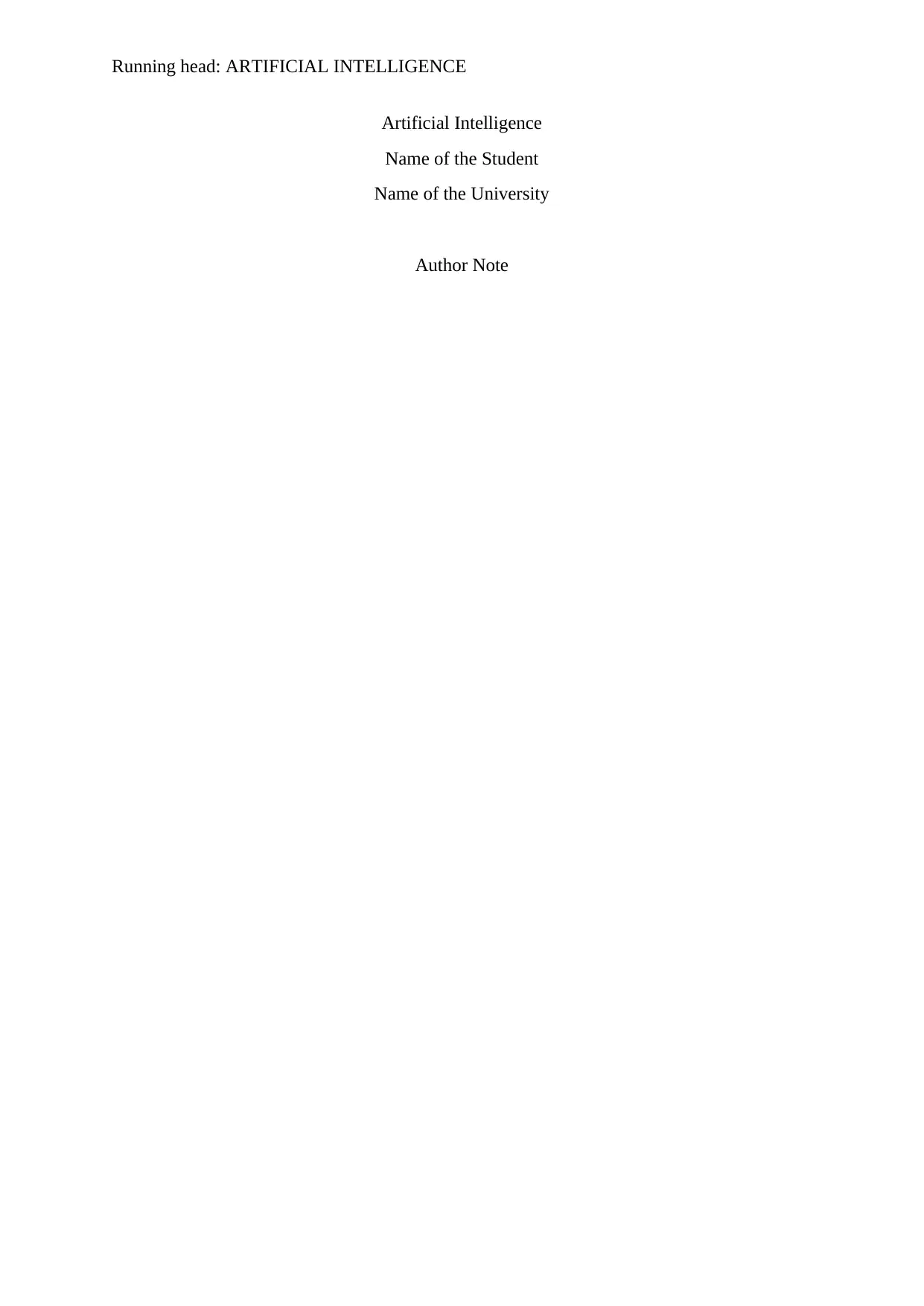
Running head: ARTIFICIAL INTELLIGENCE
Artificial Intelligence
Name of the Student
Name of the University
Author Note
Artificial Intelligence
Name of the Student
Name of the University
Author Note
Paraphrase This Document
Need a fresh take? Get an instant paraphrase of this document with our AI Paraphraser
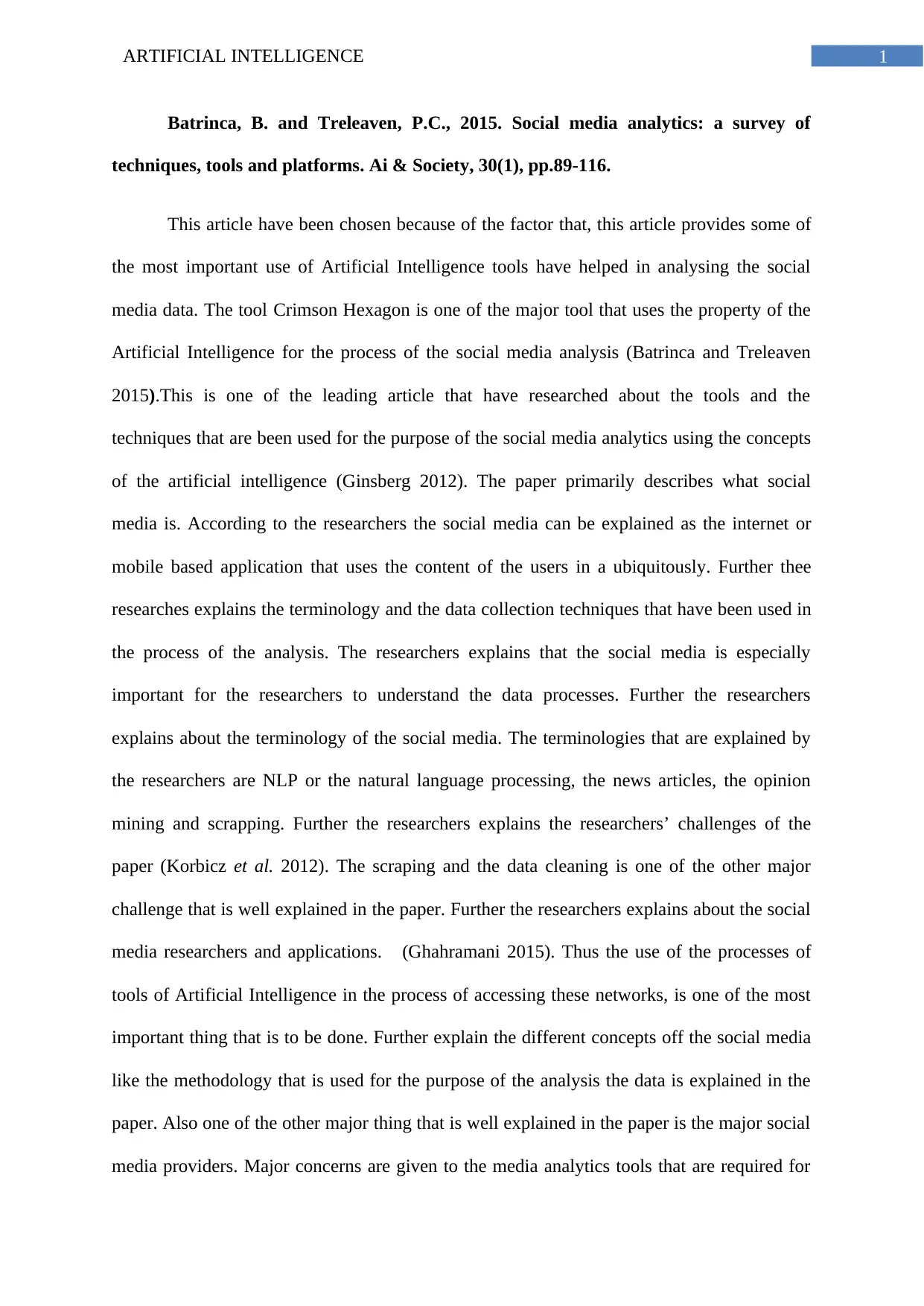
1ARTIFICIAL INTELLIGENCE
Batrinca, B. and Treleaven, P.C., 2015. Social media analytics: a survey of
techniques, tools and platforms. Ai & Society, 30(1), pp.89-116.
This article have been chosen because of the factor that, this article provides some of
the most important use of Artificial Intelligence tools have helped in analysing the social
media data. The tool Crimson Hexagon is one of the major tool that uses the property of the
Artificial Intelligence for the process of the social media analysis (Batrinca and Treleaven
2015).This is one of the leading article that have researched about the tools and the
techniques that are been used for the purpose of the social media analytics using the concepts
of the artificial intelligence (Ginsberg 2012). The paper primarily describes what social
media is. According to the researchers the social media can be explained as the internet or
mobile based application that uses the content of the users in a ubiquitously. Further thee
researches explains the terminology and the data collection techniques that have been used in
the process of the analysis. The researchers explains that the social media is especially
important for the researchers to understand the data processes. Further the researchers
explains about the terminology of the social media. The terminologies that are explained by
the researchers are NLP or the natural language processing, the news articles, the opinion
mining and scrapping. Further the researchers explains the researchers’ challenges of the
paper (Korbicz et al. 2012). The scraping and the data cleaning is one of the other major
challenge that is well explained in the paper. Further the researchers explains about the social
media researchers and applications. (Ghahramani 2015). Thus the use of the processes of
tools of Artificial Intelligence in the process of accessing these networks, is one of the most
important thing that is to be done. Further explain the different concepts off the social media
like the methodology that is used for the purpose of the analysis the data is explained in the
paper. Also one of the other major thing that is well explained in the paper is the major social
media providers. Major concerns are given to the media analytics tools that are required for
Batrinca, B. and Treleaven, P.C., 2015. Social media analytics: a survey of
techniques, tools and platforms. Ai & Society, 30(1), pp.89-116.
This article have been chosen because of the factor that, this article provides some of
the most important use of Artificial Intelligence tools have helped in analysing the social
media data. The tool Crimson Hexagon is one of the major tool that uses the property of the
Artificial Intelligence for the process of the social media analysis (Batrinca and Treleaven
2015).This is one of the leading article that have researched about the tools and the
techniques that are been used for the purpose of the social media analytics using the concepts
of the artificial intelligence (Ginsberg 2012). The paper primarily describes what social
media is. According to the researchers the social media can be explained as the internet or
mobile based application that uses the content of the users in a ubiquitously. Further thee
researches explains the terminology and the data collection techniques that have been used in
the process of the analysis. The researchers explains that the social media is especially
important for the researchers to understand the data processes. Further the researchers
explains about the terminology of the social media. The terminologies that are explained by
the researchers are NLP or the natural language processing, the news articles, the opinion
mining and scrapping. Further the researchers explains the researchers’ challenges of the
paper (Korbicz et al. 2012). The scraping and the data cleaning is one of the other major
challenge that is well explained in the paper. Further the researchers explains about the social
media researchers and applications. (Ghahramani 2015). Thus the use of the processes of
tools of Artificial Intelligence in the process of accessing these networks, is one of the most
important thing that is to be done. Further explain the different concepts off the social media
like the methodology that is used for the purpose of the analysis the data is explained in the
paper. Also one of the other major thing that is well explained in the paper is the major social
media providers. Major concerns are given to the media analytics tools that are required for
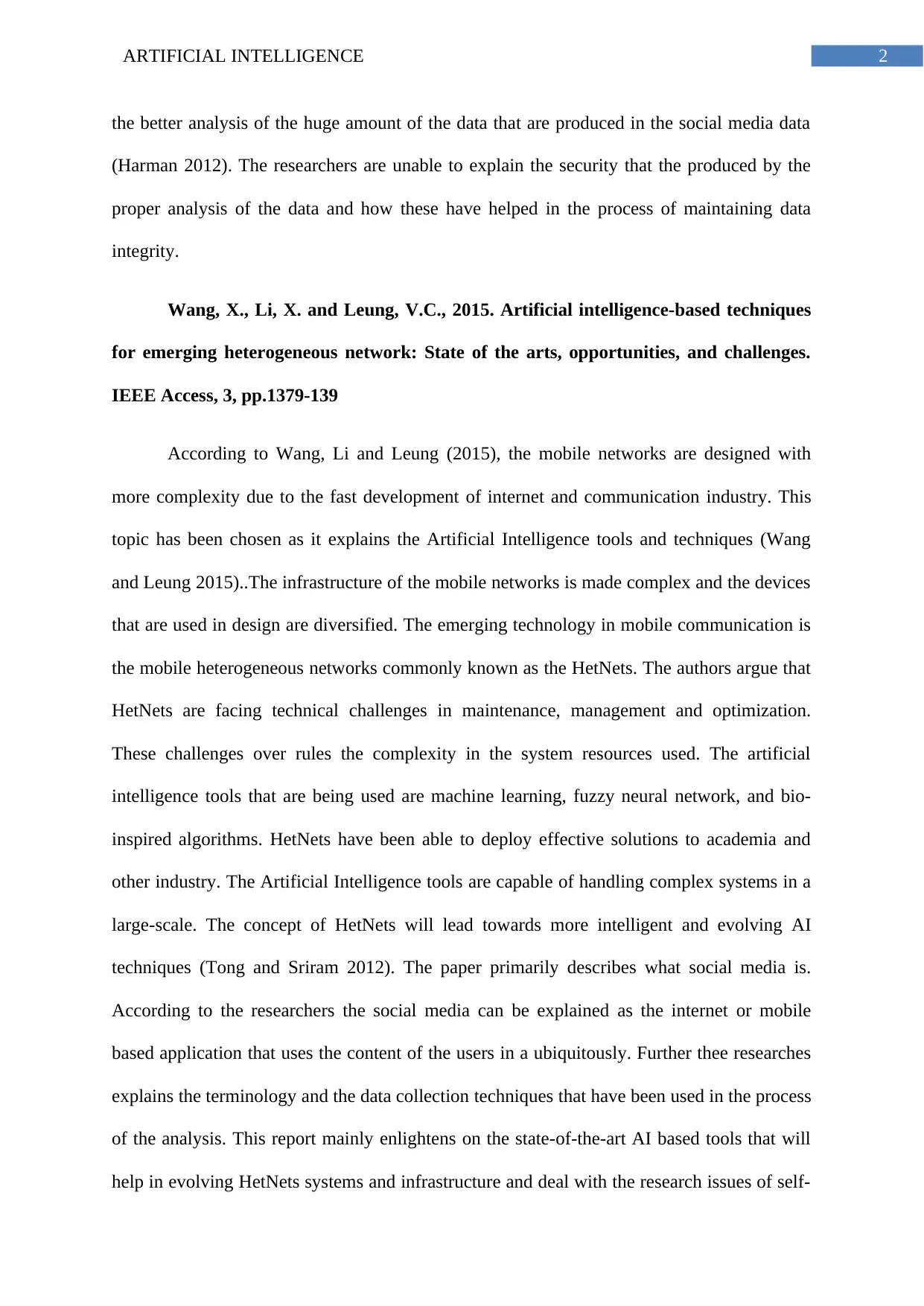
2ARTIFICIAL INTELLIGENCE
the better analysis of the huge amount of the data that are produced in the social media data
(Harman 2012). The researchers are unable to explain the security that the produced by the
proper analysis of the data and how these have helped in the process of maintaining data
integrity.
Wang, X., Li, X. and Leung, V.C., 2015. Artificial intelligence-based techniques
for emerging heterogeneous network: State of the arts, opportunities, and challenges.
IEEE Access, 3, pp.1379-139
According to Wang, Li and Leung (2015), the mobile networks are designed with
more complexity due to the fast development of internet and communication industry. This
topic has been chosen as it explains the Artificial Intelligence tools and techniques (Wang
and Leung 2015)..The infrastructure of the mobile networks is made complex and the devices
that are used in design are diversified. The emerging technology in mobile communication is
the mobile heterogeneous networks commonly known as the HetNets. The authors argue that
HetNets are facing technical challenges in maintenance, management and optimization.
These challenges over rules the complexity in the system resources used. The artificial
intelligence tools that are being used are machine learning, fuzzy neural network, and bio-
inspired algorithms. HetNets have been able to deploy effective solutions to academia and
other industry. The Artificial Intelligence tools are capable of handling complex systems in a
large-scale. The concept of HetNets will lead towards more intelligent and evolving AI
techniques (Tong and Sriram 2012). The paper primarily describes what social media is.
According to the researchers the social media can be explained as the internet or mobile
based application that uses the content of the users in a ubiquitously. Further thee researches
explains the terminology and the data collection techniques that have been used in the process
of the analysis. This report mainly enlightens on the state-of-the-art AI based tools that will
help in evolving HetNets systems and infrastructure and deal with the research issues of self-
the better analysis of the huge amount of the data that are produced in the social media data
(Harman 2012). The researchers are unable to explain the security that the produced by the
proper analysis of the data and how these have helped in the process of maintaining data
integrity.
Wang, X., Li, X. and Leung, V.C., 2015. Artificial intelligence-based techniques
for emerging heterogeneous network: State of the arts, opportunities, and challenges.
IEEE Access, 3, pp.1379-139
According to Wang, Li and Leung (2015), the mobile networks are designed with
more complexity due to the fast development of internet and communication industry. This
topic has been chosen as it explains the Artificial Intelligence tools and techniques (Wang
and Leung 2015)..The infrastructure of the mobile networks is made complex and the devices
that are used in design are diversified. The emerging technology in mobile communication is
the mobile heterogeneous networks commonly known as the HetNets. The authors argue that
HetNets are facing technical challenges in maintenance, management and optimization.
These challenges over rules the complexity in the system resources used. The artificial
intelligence tools that are being used are machine learning, fuzzy neural network, and bio-
inspired algorithms. HetNets have been able to deploy effective solutions to academia and
other industry. The Artificial Intelligence tools are capable of handling complex systems in a
large-scale. The concept of HetNets will lead towards more intelligent and evolving AI
techniques (Tong and Sriram 2012). The paper primarily describes what social media is.
According to the researchers the social media can be explained as the internet or mobile
based application that uses the content of the users in a ubiquitously. Further thee researches
explains the terminology and the data collection techniques that have been used in the process
of the analysis. This report mainly enlightens on the state-of-the-art AI based tools that will
help in evolving HetNets systems and infrastructure and deal with the research issues of self-
⊘ This is a preview!⊘
Do you want full access?
Subscribe today to unlock all pages.

Trusted by 1+ million students worldwide
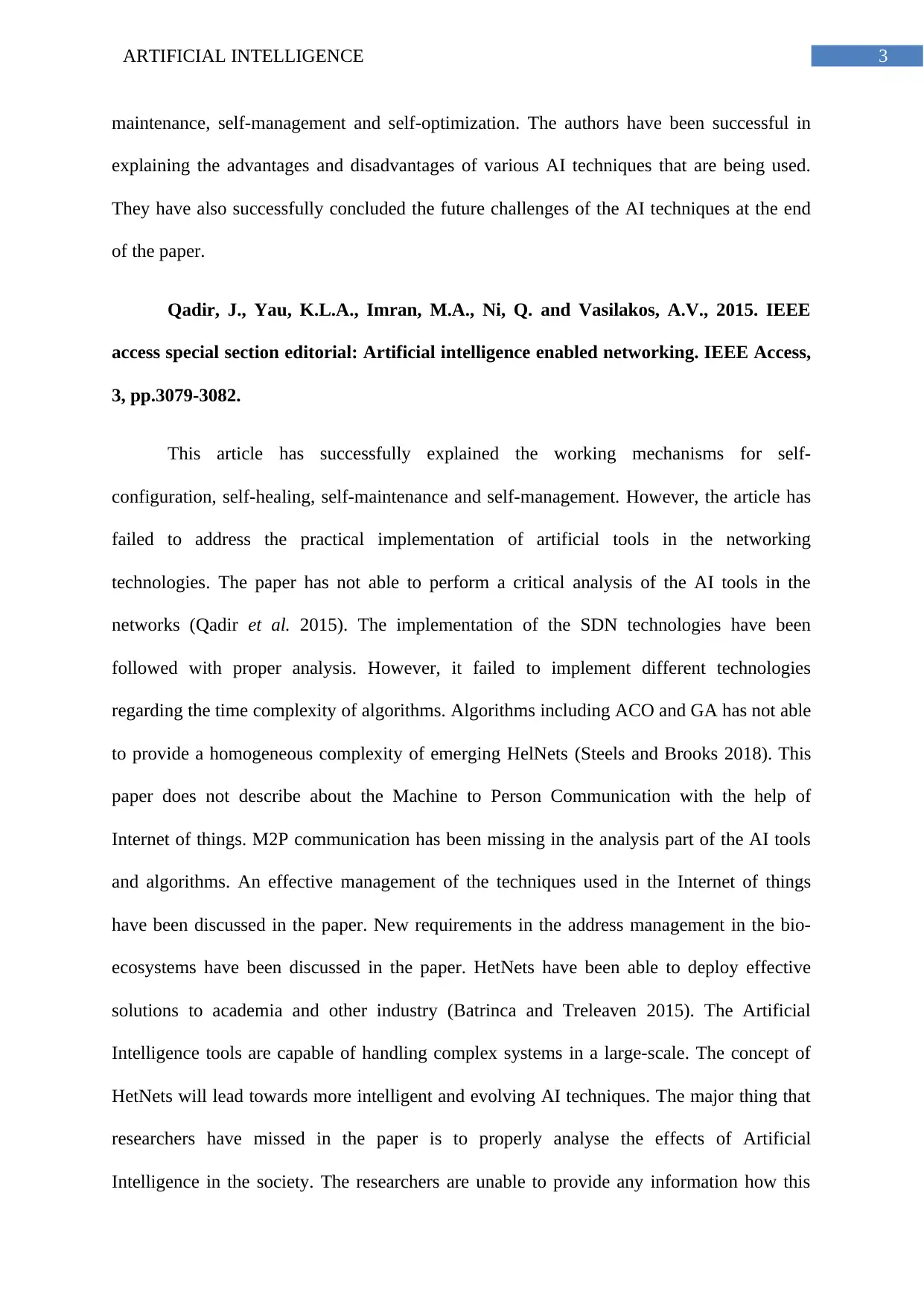
3ARTIFICIAL INTELLIGENCE
maintenance, self-management and self-optimization. The authors have been successful in
explaining the advantages and disadvantages of various AI techniques that are being used.
They have also successfully concluded the future challenges of the AI techniques at the end
of the paper.
Qadir, J., Yau, K.L.A., Imran, M.A., Ni, Q. and Vasilakos, A.V., 2015. IEEE
access special section editorial: Artificial intelligence enabled networking. IEEE Access,
3, pp.3079-3082.
This article has successfully explained the working mechanisms for self-
configuration, self-healing, self-maintenance and self-management. However, the article has
failed to address the practical implementation of artificial tools in the networking
technologies. The paper has not able to perform a critical analysis of the AI tools in the
networks (Qadir et al. 2015). The implementation of the SDN technologies have been
followed with proper analysis. However, it failed to implement different technologies
regarding the time complexity of algorithms. Algorithms including ACO and GA has not able
to provide a homogeneous complexity of emerging HelNets (Steels and Brooks 2018). This
paper does not describe about the Machine to Person Communication with the help of
Internet of things. M2P communication has been missing in the analysis part of the AI tools
and algorithms. An effective management of the techniques used in the Internet of things
have been discussed in the paper. New requirements in the address management in the bio-
ecosystems have been discussed in the paper. HetNets have been able to deploy effective
solutions to academia and other industry (Batrinca and Treleaven 2015). The Artificial
Intelligence tools are capable of handling complex systems in a large-scale. The concept of
HetNets will lead towards more intelligent and evolving AI techniques. The major thing that
researchers have missed in the paper is to properly analyse the effects of Artificial
Intelligence in the society. The researchers are unable to provide any information how this
maintenance, self-management and self-optimization. The authors have been successful in
explaining the advantages and disadvantages of various AI techniques that are being used.
They have also successfully concluded the future challenges of the AI techniques at the end
of the paper.
Qadir, J., Yau, K.L.A., Imran, M.A., Ni, Q. and Vasilakos, A.V., 2015. IEEE
access special section editorial: Artificial intelligence enabled networking. IEEE Access,
3, pp.3079-3082.
This article has successfully explained the working mechanisms for self-
configuration, self-healing, self-maintenance and self-management. However, the article has
failed to address the practical implementation of artificial tools in the networking
technologies. The paper has not able to perform a critical analysis of the AI tools in the
networks (Qadir et al. 2015). The implementation of the SDN technologies have been
followed with proper analysis. However, it failed to implement different technologies
regarding the time complexity of algorithms. Algorithms including ACO and GA has not able
to provide a homogeneous complexity of emerging HelNets (Steels and Brooks 2018). This
paper does not describe about the Machine to Person Communication with the help of
Internet of things. M2P communication has been missing in the analysis part of the AI tools
and algorithms. An effective management of the techniques used in the Internet of things
have been discussed in the paper. New requirements in the address management in the bio-
ecosystems have been discussed in the paper. HetNets have been able to deploy effective
solutions to academia and other industry (Batrinca and Treleaven 2015). The Artificial
Intelligence tools are capable of handling complex systems in a large-scale. The concept of
HetNets will lead towards more intelligent and evolving AI techniques. The major thing that
researchers have missed in the paper is to properly analyse the effects of Artificial
Intelligence in the society. The researchers are unable to provide any information how this
Paraphrase This Document
Need a fresh take? Get an instant paraphrase of this document with our AI Paraphraser
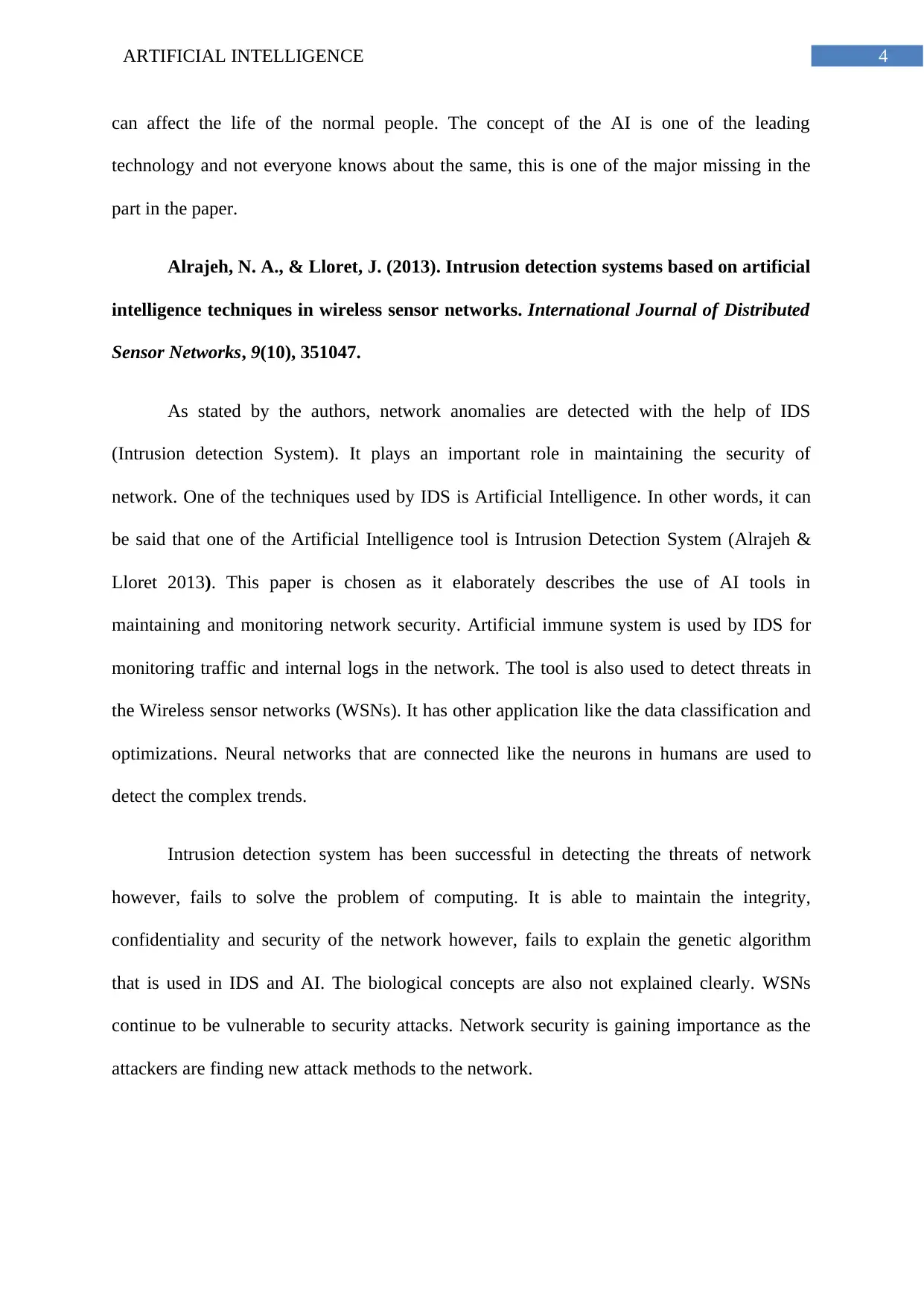
4ARTIFICIAL INTELLIGENCE
can affect the life of the normal people. The concept of the AI is one of the leading
technology and not everyone knows about the same, this is one of the major missing in the
part in the paper.
Alrajeh, N. A., & Lloret, J. (2013). Intrusion detection systems based on artificial
intelligence techniques in wireless sensor networks. International Journal of Distributed
Sensor Networks, 9(10), 351047.
As stated by the authors, network anomalies are detected with the help of IDS
(Intrusion detection System). It plays an important role in maintaining the security of
network. One of the techniques used by IDS is Artificial Intelligence. In other words, it can
be said that one of the Artificial Intelligence tool is Intrusion Detection System (Alrajeh &
Lloret 2013). This paper is chosen as it elaborately describes the use of AI tools in
maintaining and monitoring network security. Artificial immune system is used by IDS for
monitoring traffic and internal logs in the network. The tool is also used to detect threats in
the Wireless sensor networks (WSNs). It has other application like the data classification and
optimizations. Neural networks that are connected like the neurons in humans are used to
detect the complex trends.
Intrusion detection system has been successful in detecting the threats of network
however, fails to solve the problem of computing. It is able to maintain the integrity,
confidentiality and security of the network however, fails to explain the genetic algorithm
that is used in IDS and AI. The biological concepts are also not explained clearly. WSNs
continue to be vulnerable to security attacks. Network security is gaining importance as the
attackers are finding new attack methods to the network.
can affect the life of the normal people. The concept of the AI is one of the leading
technology and not everyone knows about the same, this is one of the major missing in the
part in the paper.
Alrajeh, N. A., & Lloret, J. (2013). Intrusion detection systems based on artificial
intelligence techniques in wireless sensor networks. International Journal of Distributed
Sensor Networks, 9(10), 351047.
As stated by the authors, network anomalies are detected with the help of IDS
(Intrusion detection System). It plays an important role in maintaining the security of
network. One of the techniques used by IDS is Artificial Intelligence. In other words, it can
be said that one of the Artificial Intelligence tool is Intrusion Detection System (Alrajeh &
Lloret 2013). This paper is chosen as it elaborately describes the use of AI tools in
maintaining and monitoring network security. Artificial immune system is used by IDS for
monitoring traffic and internal logs in the network. The tool is also used to detect threats in
the Wireless sensor networks (WSNs). It has other application like the data classification and
optimizations. Neural networks that are connected like the neurons in humans are used to
detect the complex trends.
Intrusion detection system has been successful in detecting the threats of network
however, fails to solve the problem of computing. It is able to maintain the integrity,
confidentiality and security of the network however, fails to explain the genetic algorithm
that is used in IDS and AI. The biological concepts are also not explained clearly. WSNs
continue to be vulnerable to security attacks. Network security is gaining importance as the
attackers are finding new attack methods to the network.
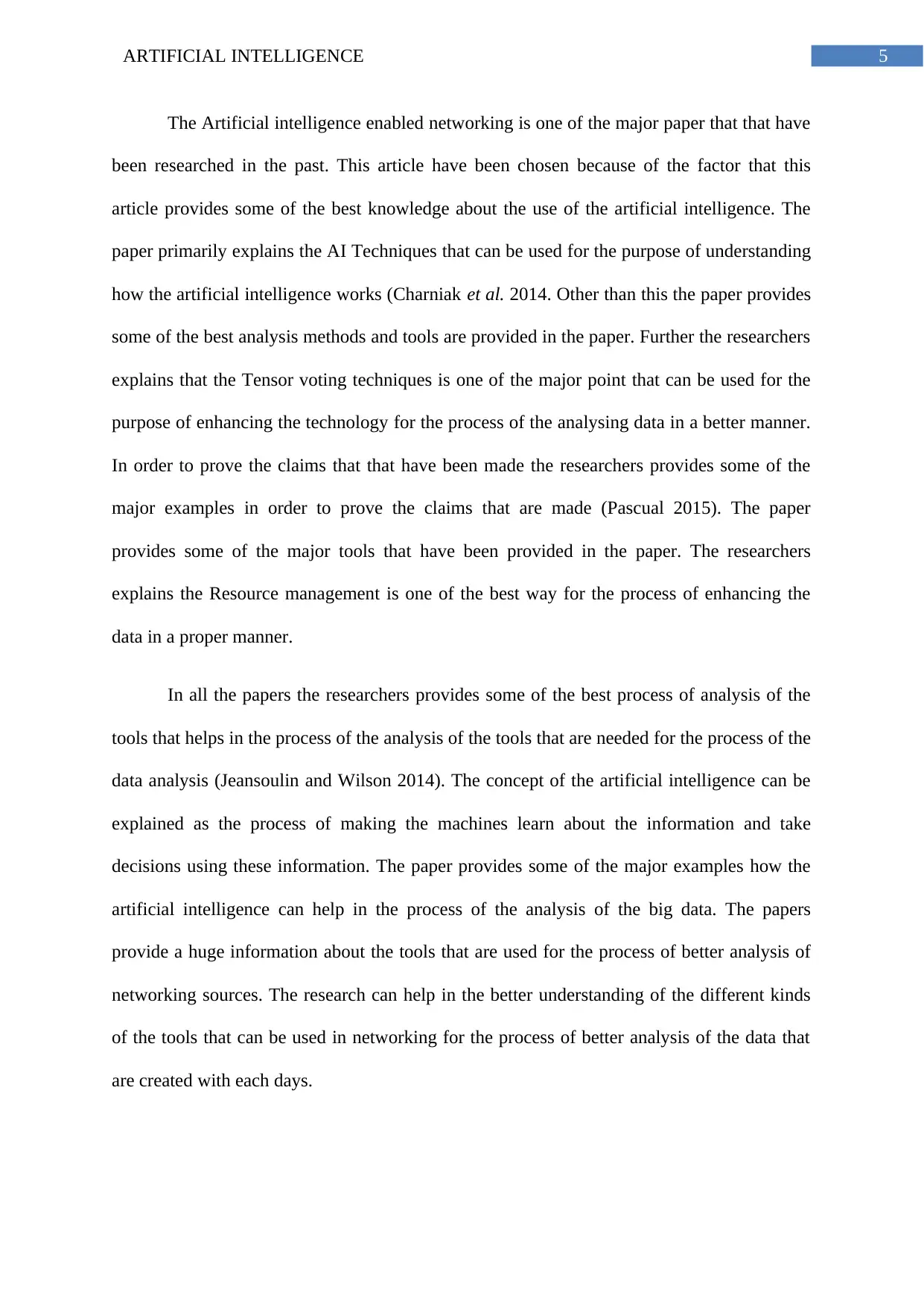
5ARTIFICIAL INTELLIGENCE
The Artificial intelligence enabled networking is one of the major paper that that have
been researched in the past. This article have been chosen because of the factor that this
article provides some of the best knowledge about the use of the artificial intelligence. The
paper primarily explains the AI Techniques that can be used for the purpose of understanding
how the artificial intelligence works (Charniak et al. 2014. Other than this the paper provides
some of the best analysis methods and tools are provided in the paper. Further the researchers
explains that the Tensor voting techniques is one of the major point that can be used for the
purpose of enhancing the technology for the process of the analysing data in a better manner.
In order to prove the claims that that have been made the researchers provides some of the
major examples in order to prove the claims that are made (Pascual 2015). The paper
provides some of the major tools that have been provided in the paper. The researchers
explains the Resource management is one of the best way for the process of enhancing the
data in a proper manner.
In all the papers the researchers provides some of the best process of analysis of the
tools that helps in the process of the analysis of the tools that are needed for the process of the
data analysis (Jeansoulin and Wilson 2014). The concept of the artificial intelligence can be
explained as the process of making the machines learn about the information and take
decisions using these information. The paper provides some of the major examples how the
artificial intelligence can help in the process of the analysis of the big data. The papers
provide a huge information about the tools that are used for the process of better analysis of
networking sources. The research can help in the better understanding of the different kinds
of the tools that can be used in networking for the process of better analysis of the data that
are created with each days.
The Artificial intelligence enabled networking is one of the major paper that that have
been researched in the past. This article have been chosen because of the factor that this
article provides some of the best knowledge about the use of the artificial intelligence. The
paper primarily explains the AI Techniques that can be used for the purpose of understanding
how the artificial intelligence works (Charniak et al. 2014. Other than this the paper provides
some of the best analysis methods and tools are provided in the paper. Further the researchers
explains that the Tensor voting techniques is one of the major point that can be used for the
purpose of enhancing the technology for the process of the analysing data in a better manner.
In order to prove the claims that that have been made the researchers provides some of the
major examples in order to prove the claims that are made (Pascual 2015). The paper
provides some of the major tools that have been provided in the paper. The researchers
explains the Resource management is one of the best way for the process of enhancing the
data in a proper manner.
In all the papers the researchers provides some of the best process of analysis of the
tools that helps in the process of the analysis of the tools that are needed for the process of the
data analysis (Jeansoulin and Wilson 2014). The concept of the artificial intelligence can be
explained as the process of making the machines learn about the information and take
decisions using these information. The paper provides some of the major examples how the
artificial intelligence can help in the process of the analysis of the big data. The papers
provide a huge information about the tools that are used for the process of better analysis of
networking sources. The research can help in the better understanding of the different kinds
of the tools that can be used in networking for the process of better analysis of the data that
are created with each days.
⊘ This is a preview!⊘
Do you want full access?
Subscribe today to unlock all pages.

Trusted by 1+ million students worldwide
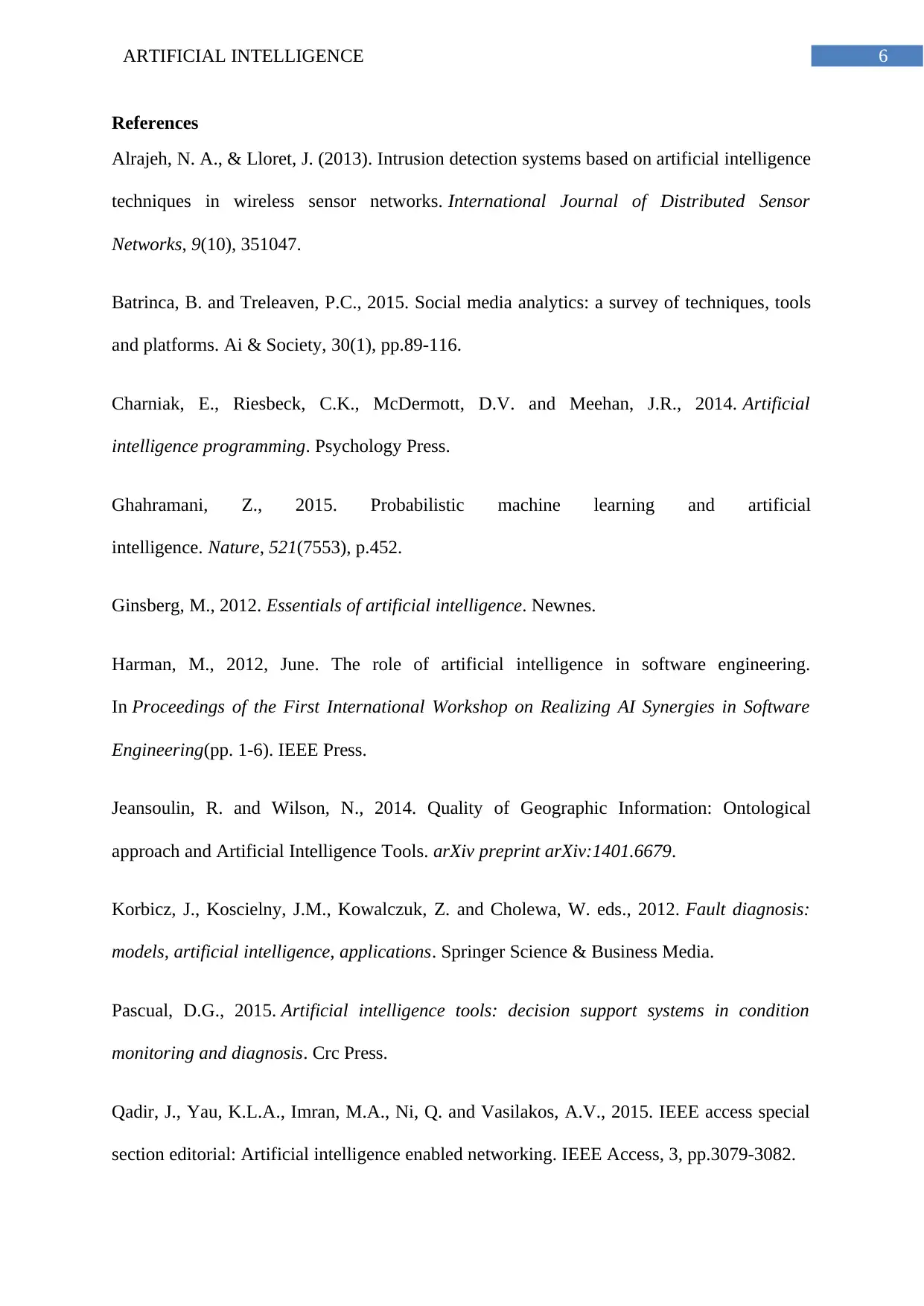
6ARTIFICIAL INTELLIGENCE
References
Alrajeh, N. A., & Lloret, J. (2013). Intrusion detection systems based on artificial intelligence
techniques in wireless sensor networks. International Journal of Distributed Sensor
Networks, 9(10), 351047.
Batrinca, B. and Treleaven, P.C., 2015. Social media analytics: a survey of techniques, tools
and platforms. Ai & Society, 30(1), pp.89-116.
Charniak, E., Riesbeck, C.K., McDermott, D.V. and Meehan, J.R., 2014. Artificial
intelligence programming. Psychology Press.
Ghahramani, Z., 2015. Probabilistic machine learning and artificial
intelligence. Nature, 521(7553), p.452.
Ginsberg, M., 2012. Essentials of artificial intelligence. Newnes.
Harman, M., 2012, June. The role of artificial intelligence in software engineering.
In Proceedings of the First International Workshop on Realizing AI Synergies in Software
Engineering(pp. 1-6). IEEE Press.
Jeansoulin, R. and Wilson, N., 2014. Quality of Geographic Information: Ontological
approach and Artificial Intelligence Tools. arXiv preprint arXiv:1401.6679.
Korbicz, J., Koscielny, J.M., Kowalczuk, Z. and Cholewa, W. eds., 2012. Fault diagnosis:
models, artificial intelligence, applications. Springer Science & Business Media.
Pascual, D.G., 2015. Artificial intelligence tools: decision support systems in condition
monitoring and diagnosis. Crc Press.
Qadir, J., Yau, K.L.A., Imran, M.A., Ni, Q. and Vasilakos, A.V., 2015. IEEE access special
section editorial: Artificial intelligence enabled networking. IEEE Access, 3, pp.3079-3082.
References
Alrajeh, N. A., & Lloret, J. (2013). Intrusion detection systems based on artificial intelligence
techniques in wireless sensor networks. International Journal of Distributed Sensor
Networks, 9(10), 351047.
Batrinca, B. and Treleaven, P.C., 2015. Social media analytics: a survey of techniques, tools
and platforms. Ai & Society, 30(1), pp.89-116.
Charniak, E., Riesbeck, C.K., McDermott, D.V. and Meehan, J.R., 2014. Artificial
intelligence programming. Psychology Press.
Ghahramani, Z., 2015. Probabilistic machine learning and artificial
intelligence. Nature, 521(7553), p.452.
Ginsberg, M., 2012. Essentials of artificial intelligence. Newnes.
Harman, M., 2012, June. The role of artificial intelligence in software engineering.
In Proceedings of the First International Workshop on Realizing AI Synergies in Software
Engineering(pp. 1-6). IEEE Press.
Jeansoulin, R. and Wilson, N., 2014. Quality of Geographic Information: Ontological
approach and Artificial Intelligence Tools. arXiv preprint arXiv:1401.6679.
Korbicz, J., Koscielny, J.M., Kowalczuk, Z. and Cholewa, W. eds., 2012. Fault diagnosis:
models, artificial intelligence, applications. Springer Science & Business Media.
Pascual, D.G., 2015. Artificial intelligence tools: decision support systems in condition
monitoring and diagnosis. Crc Press.
Qadir, J., Yau, K.L.A., Imran, M.A., Ni, Q. and Vasilakos, A.V., 2015. IEEE access special
section editorial: Artificial intelligence enabled networking. IEEE Access, 3, pp.3079-3082.
Paraphrase This Document
Need a fresh take? Get an instant paraphrase of this document with our AI Paraphraser
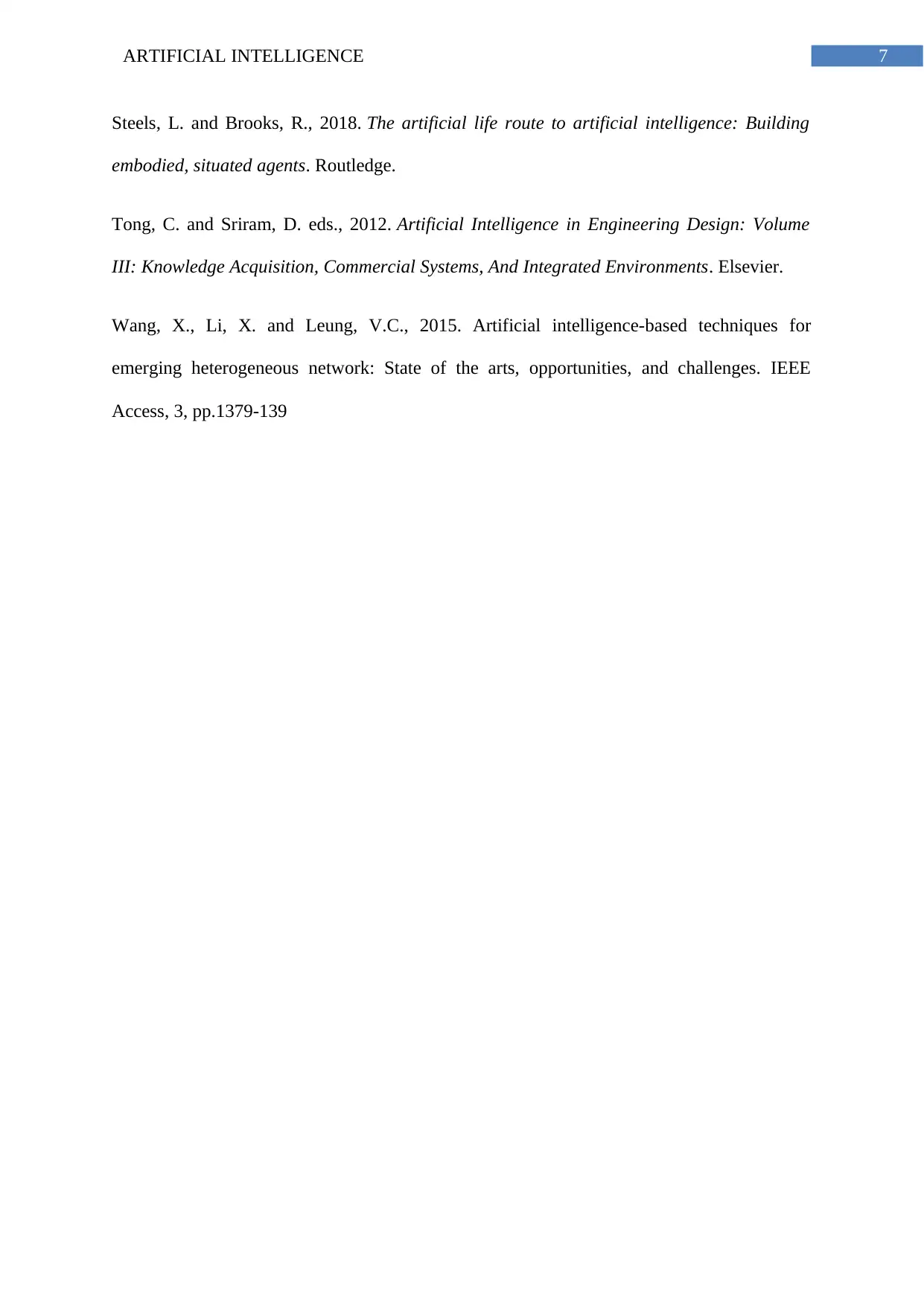
7ARTIFICIAL INTELLIGENCE
Steels, L. and Brooks, R., 2018. The artificial life route to artificial intelligence: Building
embodied, situated agents. Routledge.
Tong, C. and Sriram, D. eds., 2012. Artificial Intelligence in Engineering Design: Volume
III: Knowledge Acquisition, Commercial Systems, And Integrated Environments. Elsevier.
Wang, X., Li, X. and Leung, V.C., 2015. Artificial intelligence-based techniques for
emerging heterogeneous network: State of the arts, opportunities, and challenges. IEEE
Access, 3, pp.1379-139
Steels, L. and Brooks, R., 2018. The artificial life route to artificial intelligence: Building
embodied, situated agents. Routledge.
Tong, C. and Sriram, D. eds., 2012. Artificial Intelligence in Engineering Design: Volume
III: Knowledge Acquisition, Commercial Systems, And Integrated Environments. Elsevier.
Wang, X., Li, X. and Leung, V.C., 2015. Artificial intelligence-based techniques for
emerging heterogeneous network: State of the arts, opportunities, and challenges. IEEE
Access, 3, pp.1379-139
1 out of 8
Related Documents
Your All-in-One AI-Powered Toolkit for Academic Success.
+13062052269
info@desklib.com
Available 24*7 on WhatsApp / Email
![[object Object]](/_next/static/media/star-bottom.7253800d.svg)
Unlock your academic potential
Copyright © 2020–2025 A2Z Services. All Rights Reserved. Developed and managed by ZUCOL.





